After the great success in the mobile sector achieved by the Ryzen 4000 platform, and then the Ryzen 5000 chips, the “red” CPUs again went into the shadow of their competitors. The vast majority of work laptops today are powered by Intel processors—either the 13th-generation Core or the latest Core Ultra. An equal rival to Core Ultra will be the Ryzen AI 300 chips, announced just a month ago. But in fact, those AMD solutions that are already in mass production can be considered as an alternative to the 13th generation Core line and the average Core Ultra representatives.
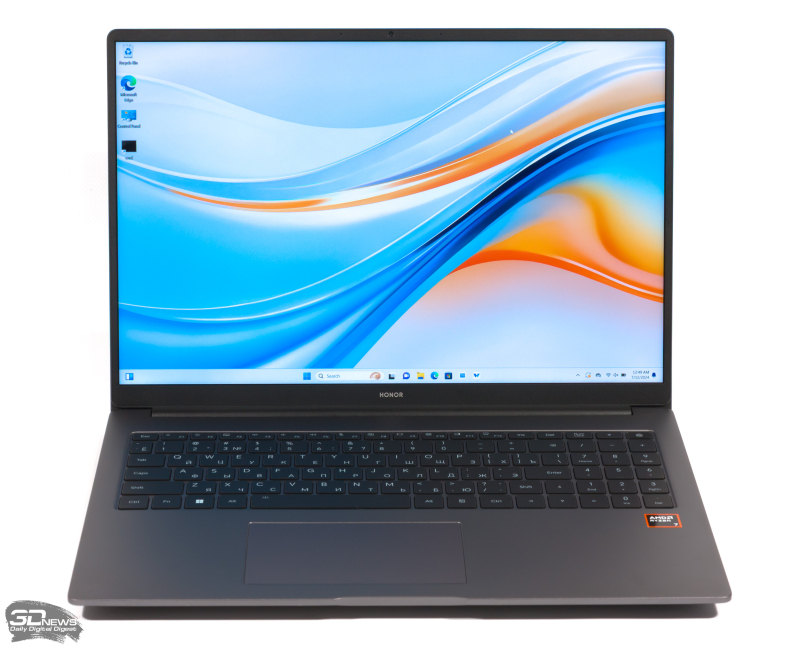
MagicBook X16 Plus – the latest model in the HONOR series of thin laptops – stands out among related devices precisely because of the Ryzen 8000 central processor.
⇡#Specifications, prices
All configurations of the MagicBook X16 Plus are equipped with the Ryzen 7 8845HS processor, which is the second oldest model among the red 8000-series SoCs for mobile PCs. The flagship of the line, Ryzen 9 8945HS, can only offer clock frequencies of the main components increased by 100–200 MHz. In turn, the Hawk Point chips themselves, on which the Ryzen 8000 mobile line is based, are an updated version of Phoenix silicon (that is, Ryzen 7000). These processors are manufactured according to the TSMC N4 technology standard in the form of a monolithic crystal. In addition, unlike competing solutions from Intel and Apple, only low-end Hawk Point models use asymmetric core organization. The Ryzen 7 8845HS has eight full-fledged Zen 4 architecture cores and operates within a TDP range of 35 to 54 W, but the creators of the MagicBook X16 Plus limited the sustainable power of the SoC to 45 W.
1 × USB4;
1 × USB 3.2 Type-C;
2 × USB 3.2 Gen 1 Type-A;
1 × HDMI;
1 × TRRS 3.5mm
The Ryzen 7 8845HS chip integrates a Radeon 780M graphics processor with 12 compute units (CUs), which contain a total of 768 shader ALUs. The RDNA 3 architecture supports DirectX 12 Ultimate capabilities, including hardware-accelerated ray tracing. Finally, the chip has a Ryzen AI coprocessor for processing data using neural networks.
MagicBook X16 Plus is equipped with LPDDR5X RAM, which operates at a speed of 6,400 MT/s, with a capacity of 16 or 32 GB. A solid-state drive with a PCI Express 4.0 interface with a capacity of 512 GB to 2 TB is used as ROM.
⇡#Appearance and ergonomics
The new product is assembled in almost the same case as the already familiar HONOR laptops based on 13th generation Intel processors – for example, MagicBook X 16 Pro 2024. The main chassis panels are made of aluminum alloy, only the screen edge and the antenna unit cover are plastic. The screen of the MagicBook X16 Plus is non-touch and covered with a matte anti-glare film. HONOR chose an IPS matrix with a resolution of 2,560 × 1,600 and a refresh rate of 120 Hz for the MagicBook X16 Plus.
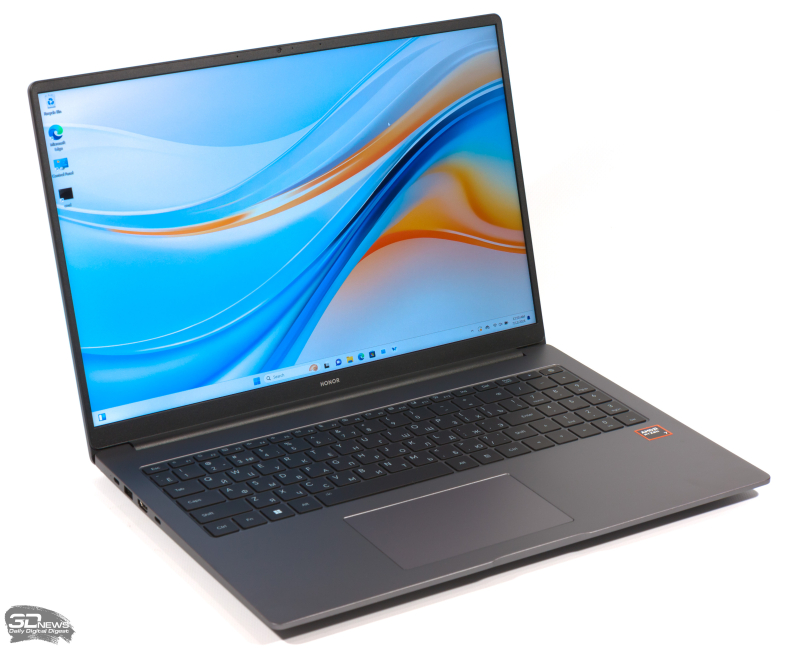
Despite its large size, the laptop body is highly rigid around the perimeter, but when you try to twist the bottom part you can still hear a quiet crunching sound. It is still impossible to lift the lid with one hand without holding the topcase. MagicBook X16 Plus comes in standard silver and space gray color options.
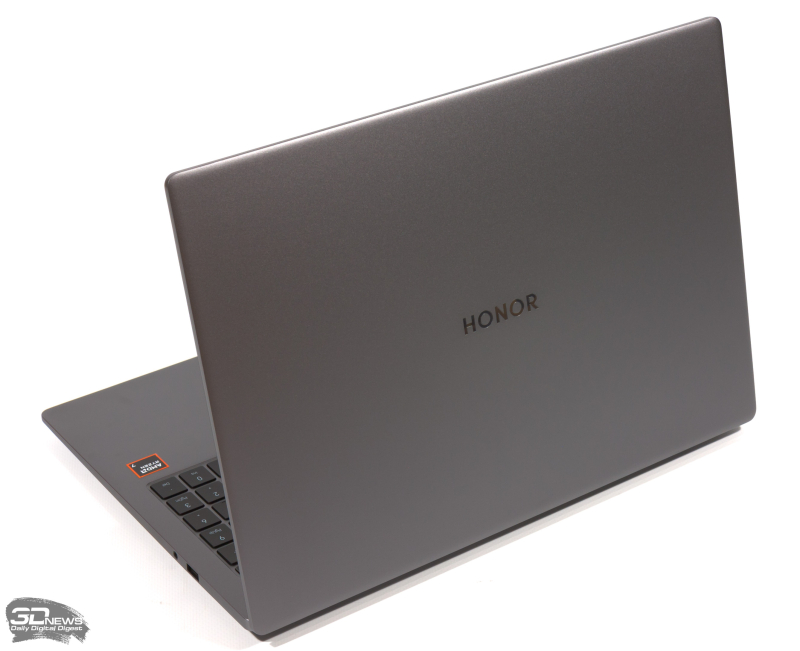
The controls of the MagicBook X16 Plus are also borrowed from related HONOR models. The keyboard with numeric keypad has a key travel of 1.5 mm, provides a clear actuation point and quick return to the neutral position. The backlight of the symbols is white, with two gradations of brightness. A fingerprint scanner is integrated into the power button. The MagicBook X16 Plus’s keyboard has only one glaring flaw, which is typical of most work laptops with rare (and expensive) exceptions: its base is noticeably deformed. Fortunately, the keyboard does not rattle while typing and is quiet.
The MagicBook X16 Plus’s touchpad is large and covered in smooth glass, but again suffers from the same problem as on the MagicBook X 16 Pro 2024. The panel doesn’t fit snugly against the switches underneath, so there’s some noise in response to a light swipe of your finger.
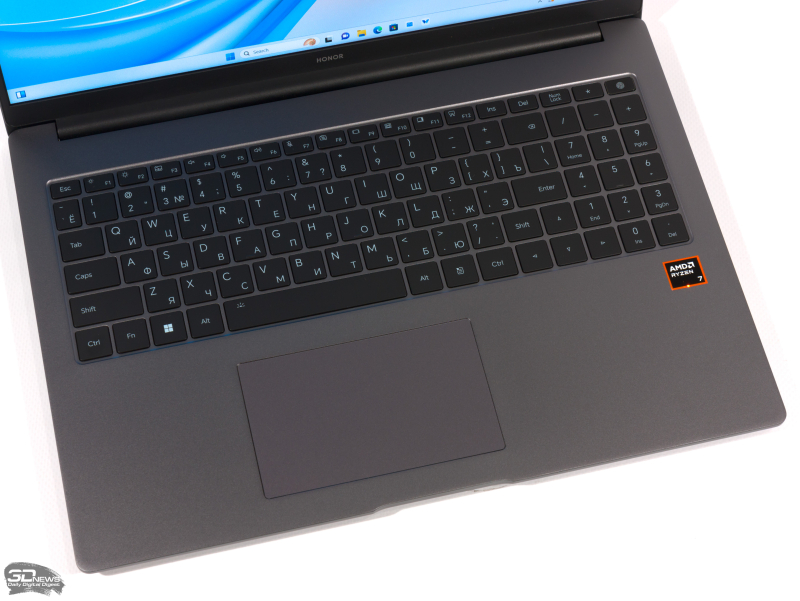
Unlike the Intel-based MagicBook X 16 Pro, the X16 Plus carries an additional USB Type-C port in addition to a pair of Type-A connectors and one Type-C, which will almost always be occupied by the charger cable. The set of cable interfaces is completed by a full-size HDMI output and a 3.5 mm mini-jack.


The custom power supply with a detachable USB Type-C cable is rated at 65 W.
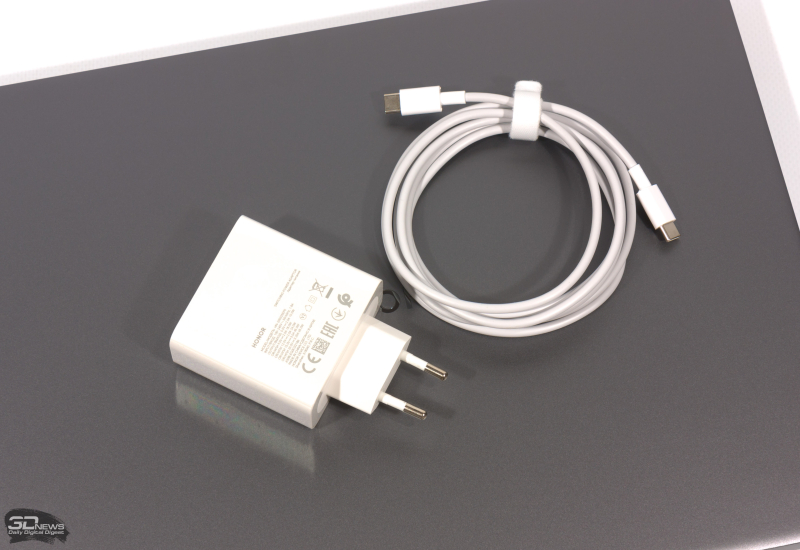
⇡#Internal design and upgrade options
Although the MagicBook X 16 Pro 2024 and MagicBook X16 Plus are built on completely different platforms, the internal components of the two laptops are very similar – right down to the position of the connectors on the motherboard. The SoC chip is also cooled by a cooler with two heat pipes and one radial fan.
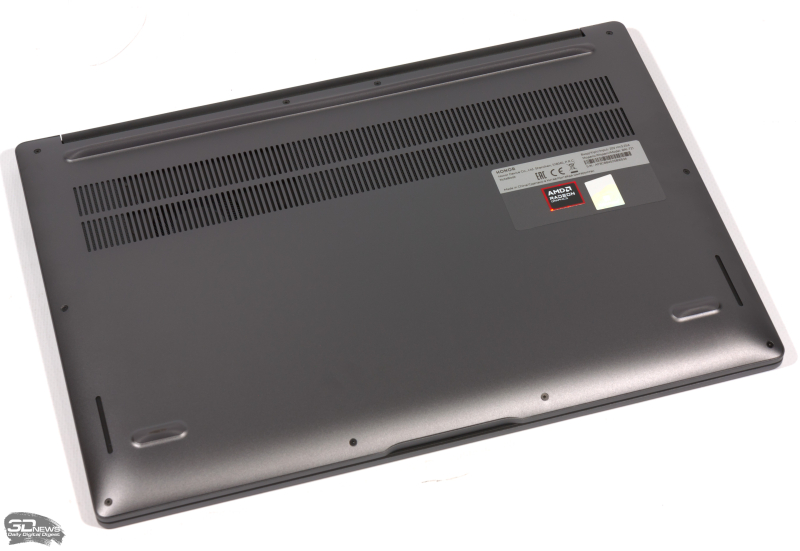
The LPDDR5X RAM cannot be expanded, but the solid-state drive can be upgraded by the user. The MagicBook X16 Plus has a free M.2 connector, which is hidden under an insulating sticker next to the already installed SSD, although only short modules of the M.2 2242 form factor are suitable for it.
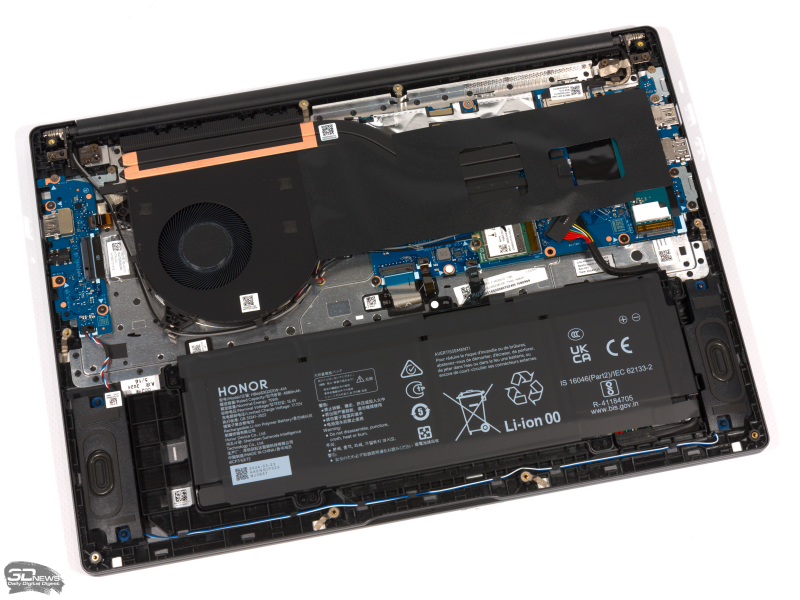
⇡#Testing methodology
GPU Benchmark: Vulkan (Windows)/Metal (macOS)
In order to demonstrate maximum performance, we disable the VBS (Virtualisation-Based Security) and Memory Integrity (Hypervisor-protected Code Integrity) functions in Windows 11.
Screen testing is performed using an X-Rite i1Display Pro Plus colorimeter in the DisplayCAL 3 application.
Laptop battery life is measured with a display brightness of 200 cd / m2 in the following usage scenarios:
- Alternately opening and closing websites at 25 sec intervals in Google Chrome or Safari browser (cache disabled);
- Continuous playback of 4K video in HEVC format.
⇡#Test participants
The following devices took part in testing:
⇡#Screen quality
The MagicBook X16 Plus screen has a high brightness of 470 cd/m2 and an average contrast ratio of 1,513:1 for IPS panels without local dimming.
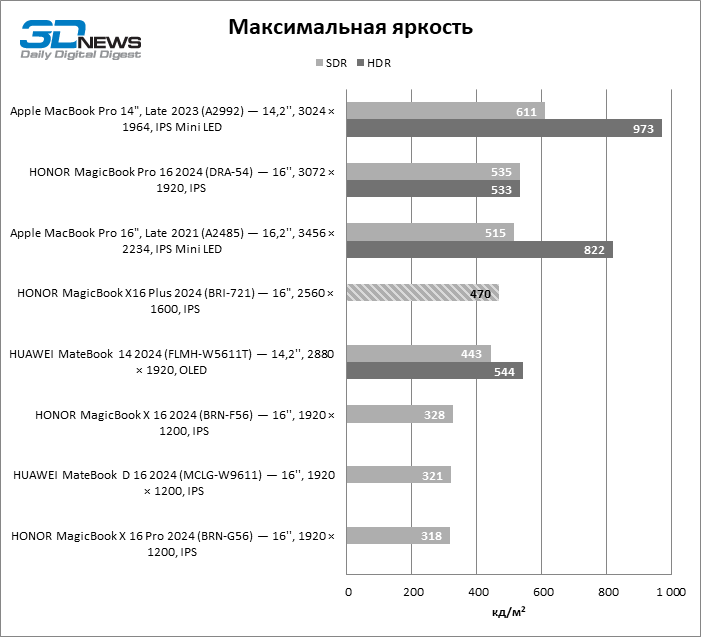

The color range of the matrix almost entirely covers the sRGB space.
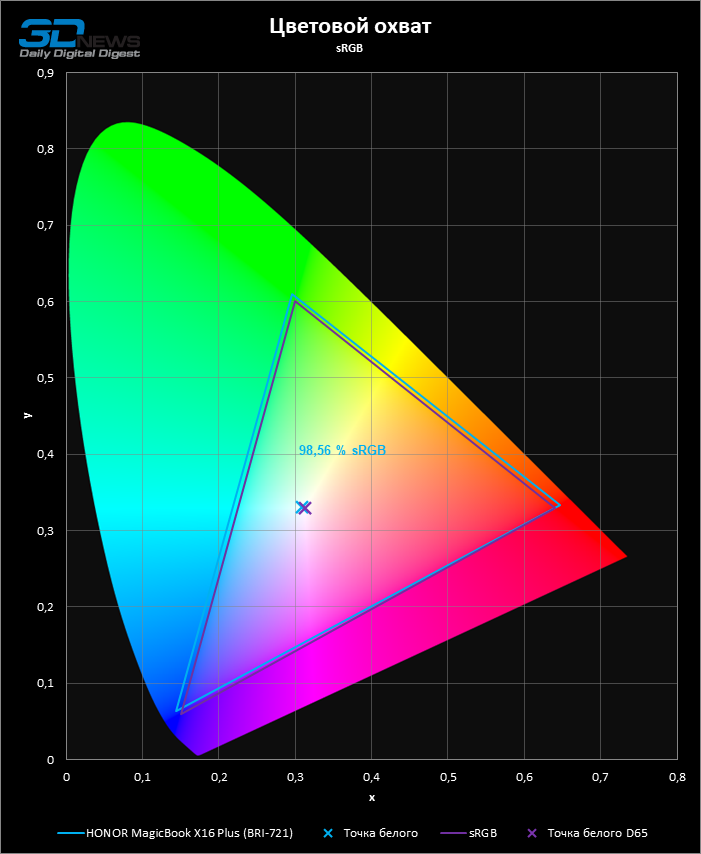
In turn, the color temperature is precisely tuned to the reference value of 6500 K.
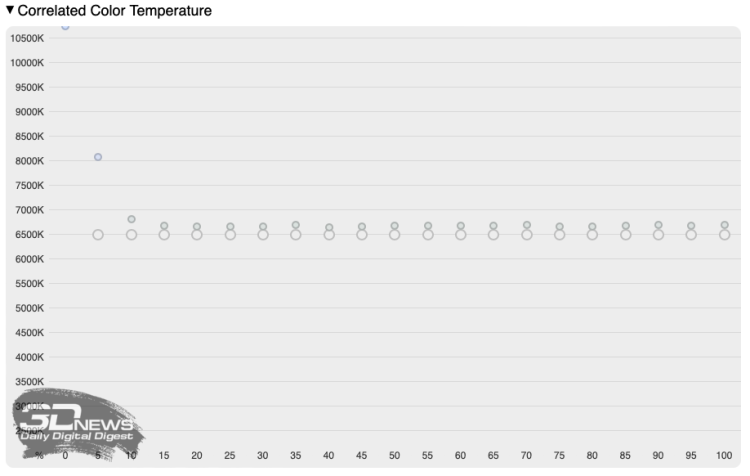
The gamma correction curve is close to a power function with an exponent of 2.1.
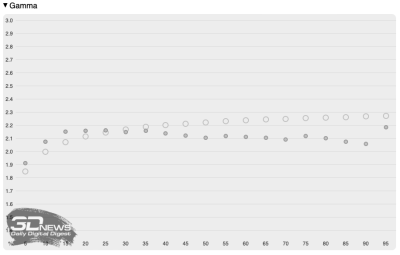

With excellent gray balance and almost full coverage of the sRGB color space, the MagicBook X16 Plus’ screen earns high marks for color accuracy when displaying relevant content.
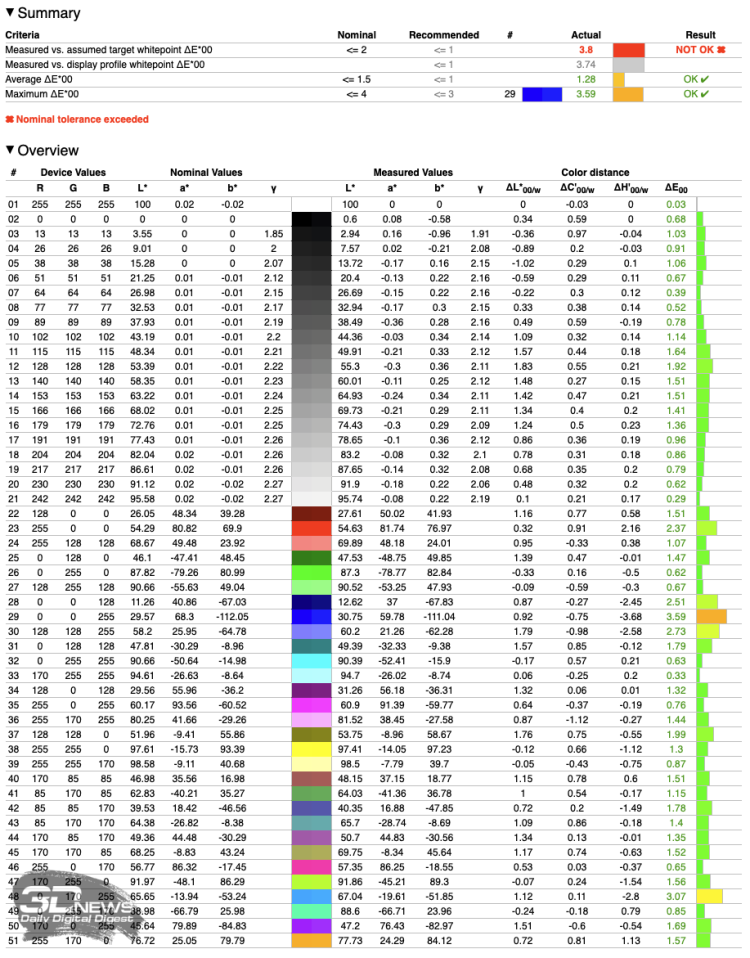
⇡#Clock frequencies, temperature and noise level
MagicBook X16 Plus allows the Ryzen 7 8845HS processor to operate in two different power modes – Smart and High Performance. When high-performance mode is active, sustained die power consumption reaches 45 W, the CPU cores maintain a high clock speed of 4.1 GHz under sustained multi-threaded loads, and the Radeon 780M integrated graphics clocks at 2.7 GHz. Under conditions of maximum combined load on the CPU and GPU, their average clock speeds fluctuate around 3.7 and 2 GHz, respectively.
In turn, the “smart” mode reduces the power allocated to the processor to 35 W. The average x86 core clock is hovering around 3.8 GHz, while the integrated GPU is still clocked at 2.7 GHz. With a combined load, the x86 cores and Radeon 780M graphics operate at 3.4 and 1.7 GHz, respectively.
Unfortunately, the MagicBook X16 Plus does not have enough 65-watt power supply to provide the Ryzen 7 8845HS crystal with maximum sustainable power, so the laptop begins to consume battery power during prolonged use. In addition, we noticed that sometimes during long tests the chip’s sustained power drops to 22-25W, although none of the SoC sensors indicate overheating, and other times the laptop passes any test without surprises. Hopefully this is a software defect that HONOR can fix with a UEFI update.
Approx. The measurement is performed after warming up the device and stabilizing all parameters.
In high-performance mode, the SoC crystal reaches a temperature of 97 ° C, and the noise level of the cooling system tends to 44 dBA. “Smart” mode reduces these figures to 83 ° C and 41.2 dBA.
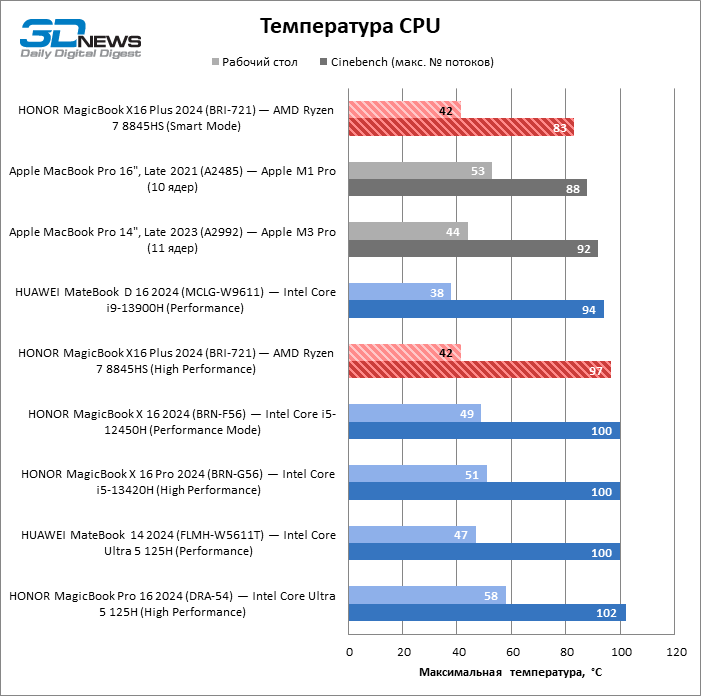
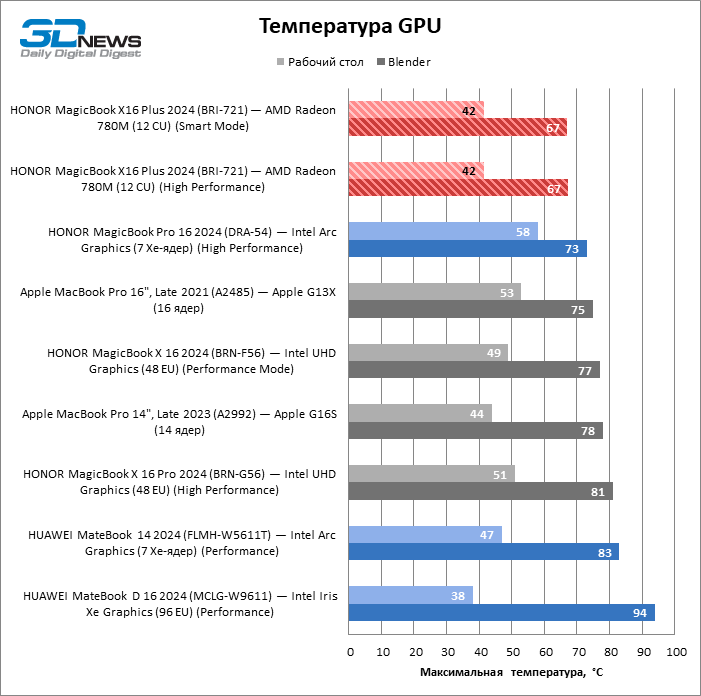

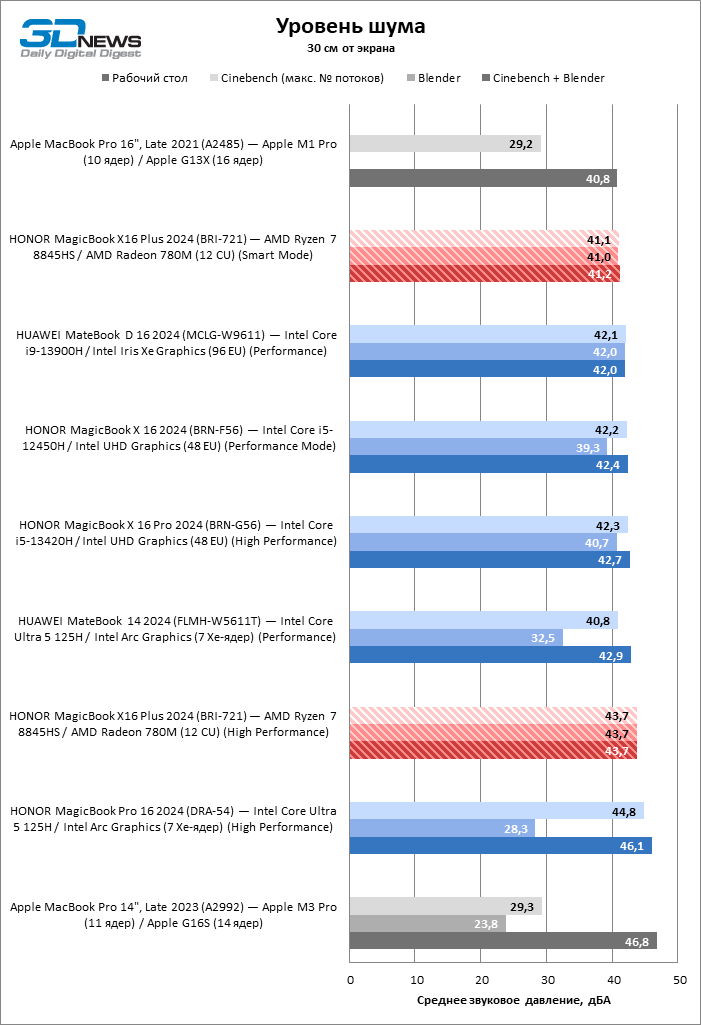
Finally, the temperature of the topcase does not exceed 46 °C in the hottest spots – above the SoC crystal and at the point where the hot air exits.
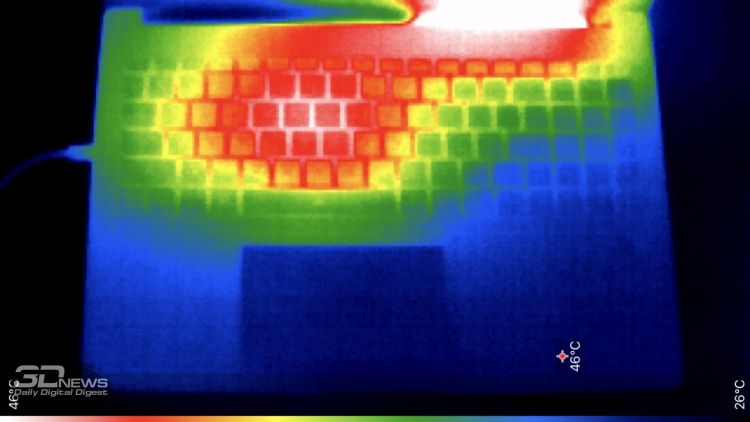
⇡#Synthetic performance tests
In the long multi-threaded Cinebench R23 test, the Ryzen 7 8845HS chip outperformed all rivals, including Intel’s 65W Core Ultra 5 125H and the 11-core version of the Apple M3 Pro. In terms of single-threaded performance, the Ryzen 7 8845HS is on par with the Core Ultra 5 125H and surpasses the Apple M1 Pro, but is inferior to the Core i9-13900H and M3 Pro.
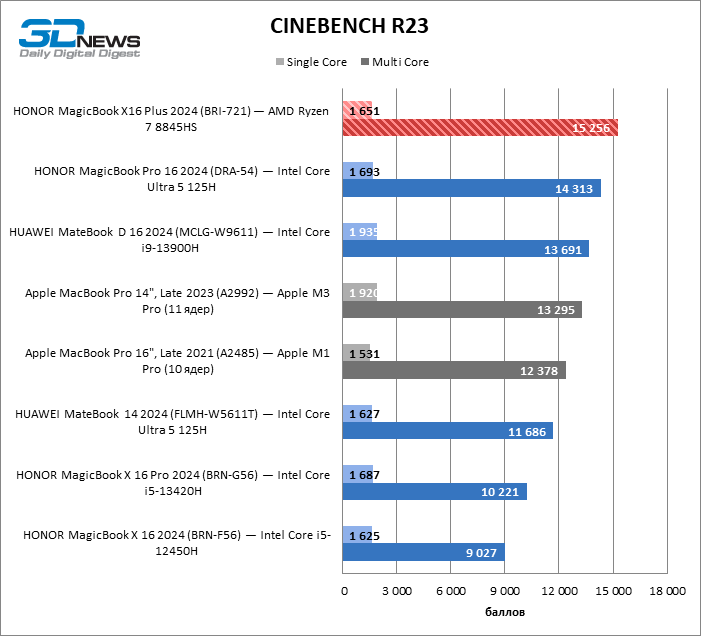
According to the results of short multi-threaded Geekbench 6 tests, the “red” processor left behind the Core Ultra 5 125H and Apple M1 Pro, but was ahead of the Core i9-13900H and Apple M3 Pro. In single-threaded mode, the Ryzen 7 8845HS is again ahead of the Core Ultra 5 125H, but cannot compete with the Core i9-13900H and especially the M3 Pro.

In turn, the GP-GPU benchmark in Geekbench 6 ranked the integrated graphics of the Radeon 780M higher than the Intel Arc with seven Xe cores, but the speed of the integrated GPU of Apple processors is more than twice as fast.

Synthetic game rendering tests, on the contrary, were more difficult for the Radeon 780M than for Intel’s new generation graphics. Under certain conditions, the Radeon 780M is even inferior to the Iris Xe video core with a full set of execution units.
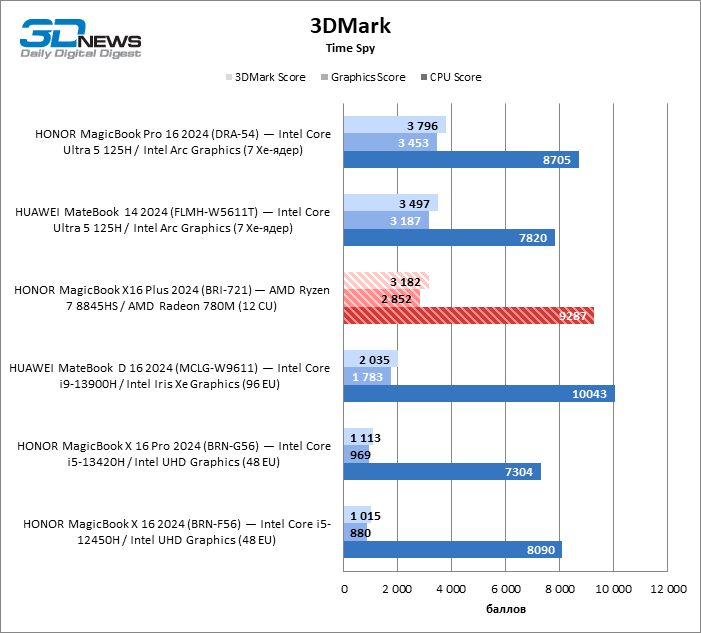
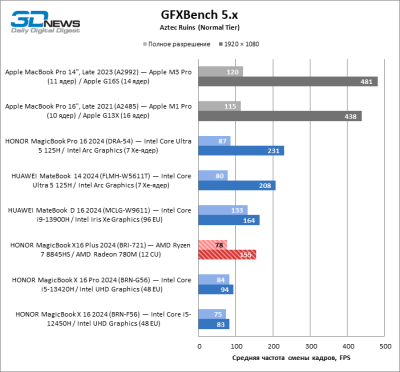
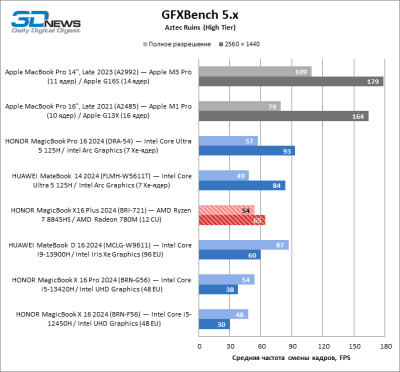
⇡# Performance in production applications
In the Blender benchmark, when rendering using the CPU, the Ryzen 7 8845HS took first place, 4 seconds ahead of the 11-core version of the Apple M3 Pro.
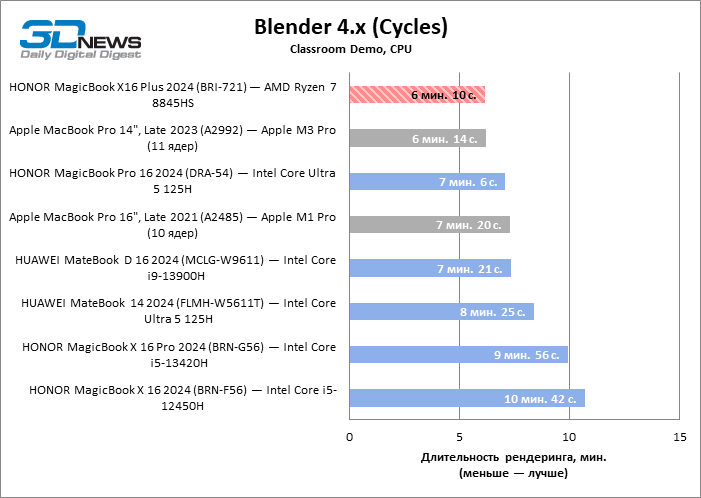
But the integrated graphics Radeon 780M is significantly inferior in performance to both Apple solutions and the integrated version of Intel Arc with seven Xe cores.

In the Lightroom Classic test, which traditionally favors Intel CPUs, the MagicBook X16 Plus is not inferior to laptops with Core Ultra chips of category H.
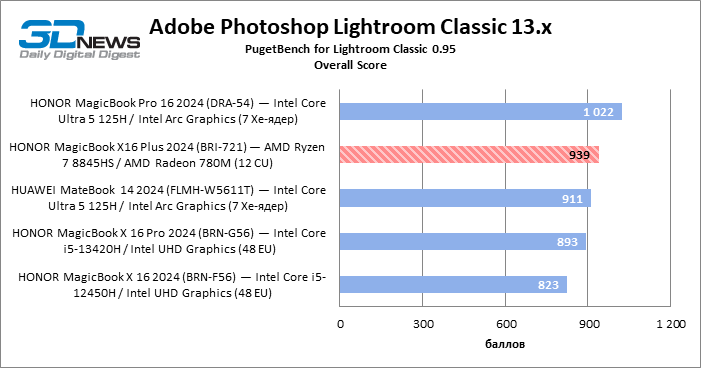
Approx. Points are calculated as a percentage of the performance of a reference workstation with an Intel Core i9-9900K, NVIDIA GeForce RTX 2080 and 64GB of RAM multiplied by 10.
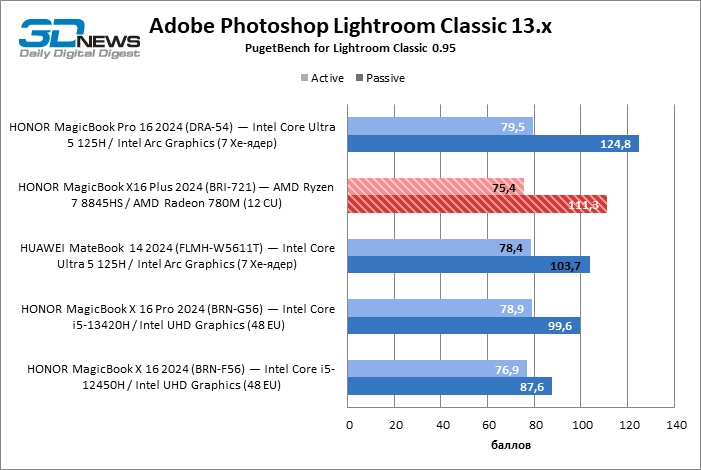
Approx. Points are calculated as a percentage of the performance of a reference workstation with Intel Core i9-9900K, NVIDIA GeForce RTX 2080 and 64GB RAM.
In terms of performance in Photoshop, the AMD processor has completely left behind all its “blue” competitors, but lags behind Apple chips, including the 10-core M1 Pro.
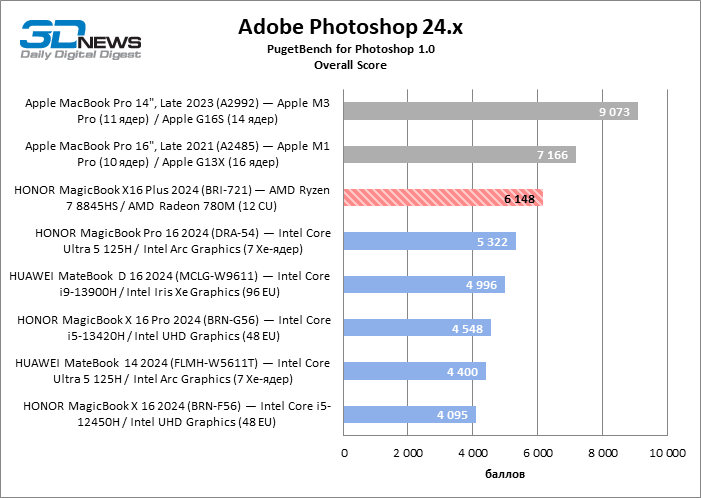
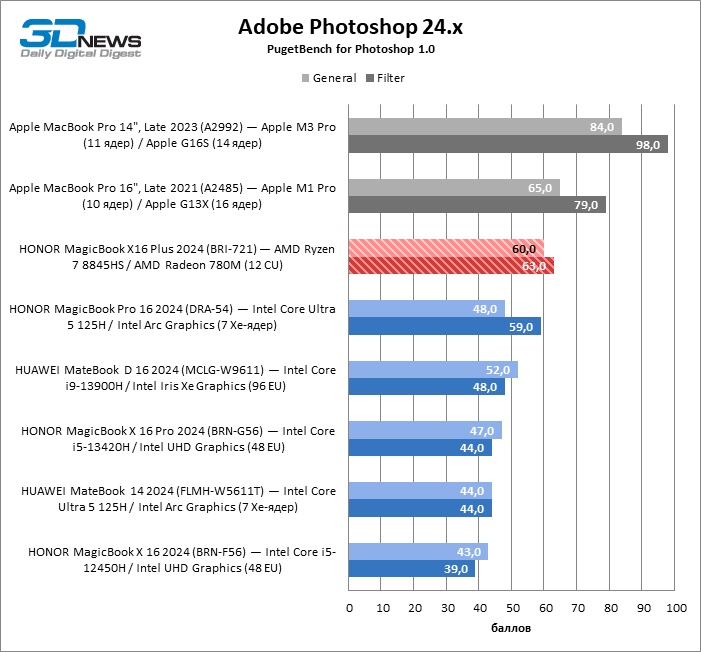
In the Premiere Pro benchmark, among laptops without a discrete GPU, MacBooks traditionally lead, and among representatives of the x86 architecture, the Ryzen 7 8845HS processor was ahead only of the Core Ultra 5 125H with power consumption increased to 65 W.
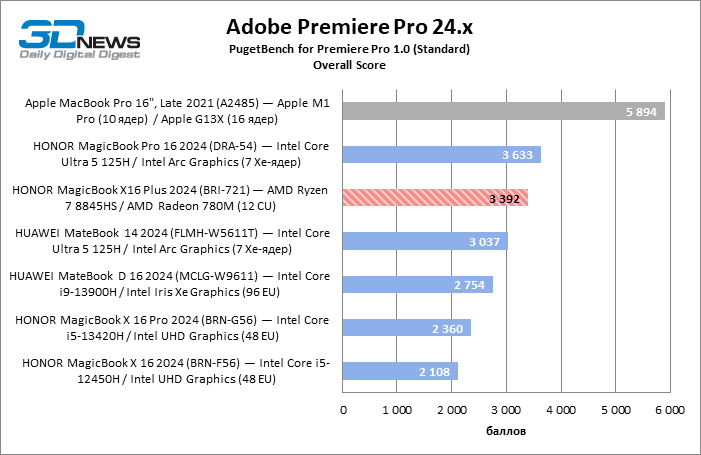

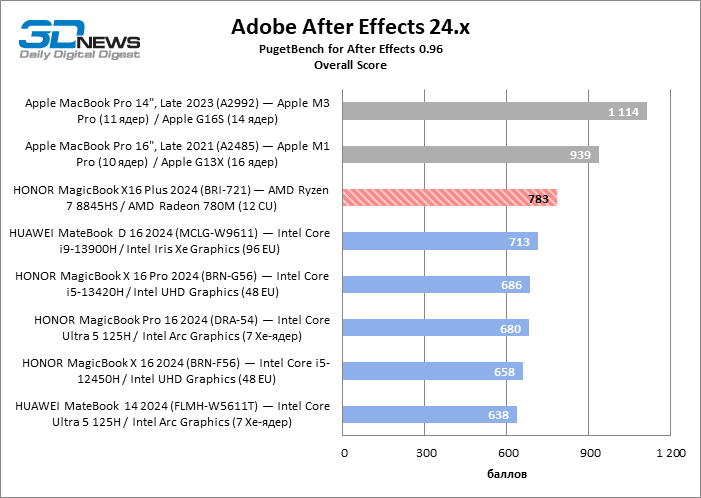
Note: Scores are calculated as a percentage of the performance of a reference workstation with an Intel Core i9-11900K, NVIDIA GeForce RTX 3080, and 64GB of RAM, multiplied by 10.

Note: Scores are calculated as a percentage of the performance of a reference workstation with an Intel Core i9-11900K, NVIDIA GeForce RTX 3080, and 64GB of RAM.
⇡#SSD performance
The MagicBook X16 Plus review unit has a 1 TB KIOXIA BG5 SSD. In contrast to the same 512 GB SSD, the terabyte version develops an acceptable linear write speed, but in terms of a set of basic performance metrics, excluding random read, it still lags behind common OEM solutions with the PCI Express 4.0 interface.




⇡# Battery life
In terms of operating time in a web browser on a single charge (7.5 hours), the MagicBook X16 Plus battery is not inferior to similar laptops with 13th generation Intel processors or Core Ultra, but lasted less (9.5 hours) with continuous playback of HEVC video.

⇡#Conclusions
Although AMD processors are once again out of favor with laptop manufacturers, tests of the new MagicBook X16 Plus showed that the Ryzen 8000 is a very competitive platform. Yes, these chips do not claim to be leaders in performance among mobile SoCs, but in most operating benchmarks the eight-core Ryzen 7 8845HS outperforms the 14-core Core i9-13900H and Core Ultra 5 125H – the junior model of the current Intel line with a 4+8+2 core formula . Under certain circumstances, the Ryzen 7 8845HS can even compete with the 11-core version of the Apple M3 Pro.
In terms of energy efficiency, the MagicBook X16 Plus allows you to count on almost the same web browsing time as similar laptops with Intel chips on board. The only thing that disappoints AMD mobile silicon is the performance of the integrated GPU. Progress is obvious, but the Radeon 780M is inferior not only to Intel Arc in a stripped-down configuration, but sometimes to the old Intel Iris Xe video core, not to mention Apple products. Additionally, we noticed some oddities in the processor’s power management, which we hope can be fixed with a software update.
The MagicBook X16 Plus laptop itself is a close relative of another HONOR model – the MagicBook X 16 Pro 2024. The common weakness of the two machines is a relatively slow SSD, and even minor flaws in the chassis mechanics. But in addition to the powerful “red” processor, the Plus version has a lot of advantages – a higher-capacity battery, an additional USB Type-C port, 2.5K screen resolution with a 120 Hz refresh rate – and comes in RAM and ROM configurations up to 32 GB and 2 TB respectively.